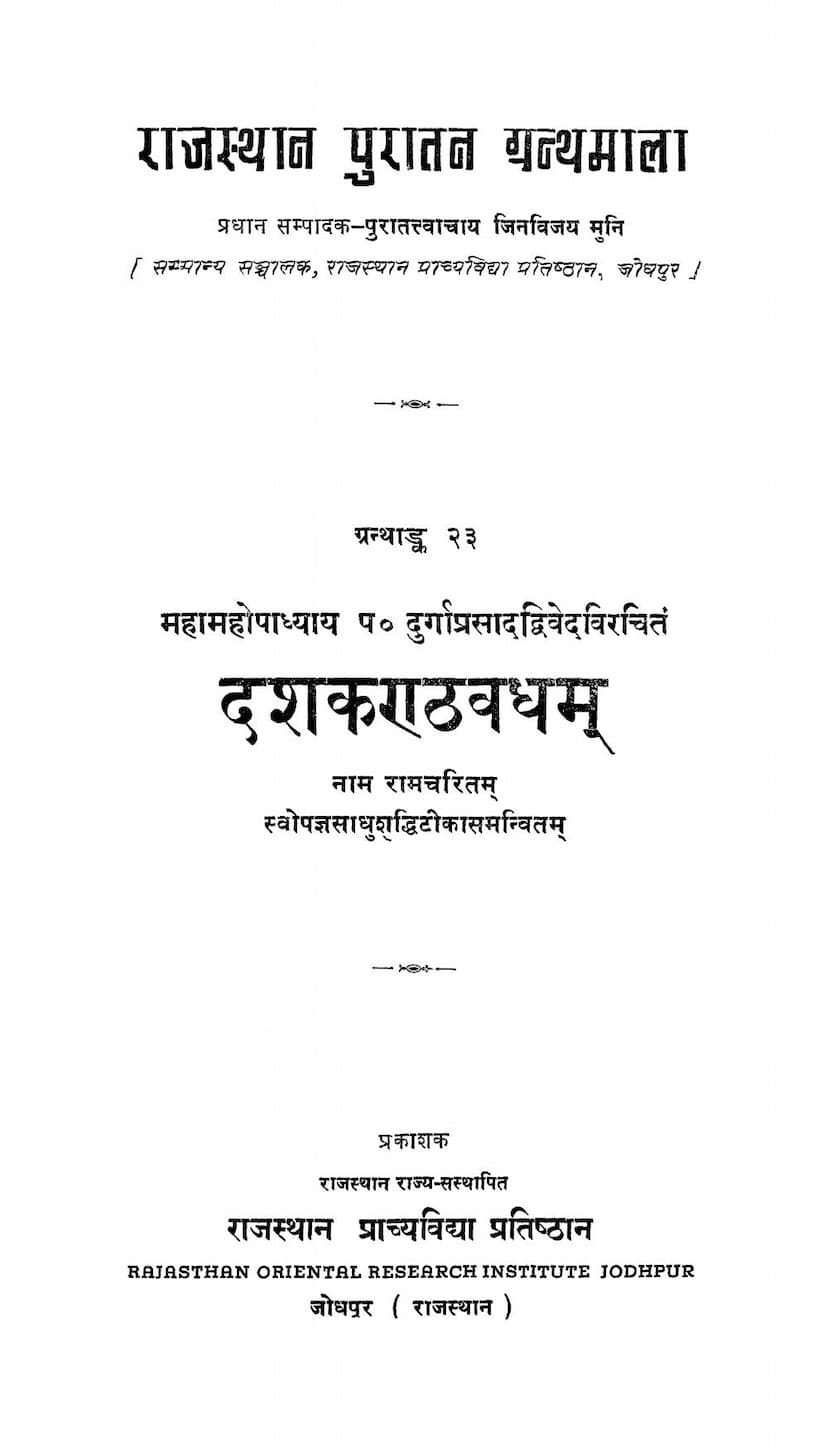Dashkanthvadham
Added to library: September 1, 2025

Summary
The book "Dashkanthavadh" (दशकण्ठवधम्), also known as "Ram Charitam" (रामचरितम्), authored by Mahamahopadhyay Pt. Durgaprasad Dwivedi, is a significant work published by Rajasthan Prachyavidya Pratishthan, Jodhpur. It is part of the "Rajasthan Puratan Granthmala" series. The text is a poetic retelling of the Ramayana, focusing on the life and deeds of Rama.
Here's a summary of the key aspects based on the provided pages:
Overall Nature and Content:
- Epic Poem: "Dashkanthavadh" is a Sanskrit epic poem that narrates the story of Lord Rama. The title itself, "Dashkanthavadh," directly refers to the slaying of Ravana, who has ten heads. The alternative title, "Ram Charitam," highlights its focus on Rama's life.
- Jain Context (Implied): While the core narrative is the Ramayana, the inclusion within a Jain context and the emphasis on certain philosophical discussions might hint at a Jain interpretation or perspective, although the provided pages primarily focus on the philosophical and poetic aspects of the Ramayana narrative.
- Commentary: The book includes a commentary titled "Sadhu Shuddhi Teeka" (साधुशुद्धि टीका), suggesting an explanatory or interpretive layer to the main text.
- Structure: The text is presented in "Gucchak" (गुच्छक), which are sections or chapters. The provided pages cover the beginning of the first Gucchak, a significant portion of the second, and the start of the third, dealing with philosophical discussions and the initial parts of Rama's life and the context of the epic.
Key Themes and Philosophical Discussions:
The initial sections of the book delve into profound philosophical concepts, often using the Ramayana narrative as a backdrop for these discussions:
- Nature of Brahman and the Self (Atman): There are extensive explorations of Brahman, the ultimate reality, its relationship with the individual self (Atman), and the various philosophical schools' interpretations of these concepts (Vedanta, Sankhya, Yoga, Mimamsa). The text emphasizes the non-dualistic (Advaita) perspective, where the Atman and Brahman are ultimately one.
- The Problem of Maya and Illusion: The nature of the phenomenal world (Maya) is discussed, highlighting its illusory and transient nature. The text contrasts the perceived reality of the world with the ultimate reality of Brahman.
- The Cycle of Birth and Death (Samsara): The text touches upon the concept of Samsara, the continuous cycle of birth, death, and rebirth, driven by karma and ignorance.
- The Goal of Liberation (Moksha): The ultimate goal of spiritual pursuit, liberation from Samsara, is presented as the cessation of suffering and the attainment of union with the divine.
- The Role of Knowledge and Action: The text discusses the importance of knowledge (Jnana) and righteous action (Karma) in achieving liberation. It suggests that true understanding, rather than mere ritualistic action, leads to liberation.
- The Importance of Contemplation and Renunciation: The philosophical sections highlight the need for contemplation (Dhyana), detachment from worldly desires, and renunciation of ego and worldly attachments.
- The Nature of Suffering: Various types of suffering arising from the senses, mind, desires, and the cycle of existence are discussed, emphasizing their root in ignorance and attachment.
- The Concept of Purushartha (Effort): There's a strong emphasis on "Purushartha" (human effort) as the means to achieve spiritual goals, rather than solely relying on fate or divine intervention. The text argues that righteous effort, guided by scripture and wisdom, is crucial.
- The Character of Ideal Beings: The text describes the characteristics of enlightened beings and the qualities one should cultivate, such as detachment, equanimity, wisdom, and compassion.
Narrative Elements:
- Sage Valmiki and Narada: The narrative begins with Valmiki, the author of the original Ramayana, encountering the sage Narada, who prompts him to compose the epic.
- The Story of the Krauncha Bird: The famous incident where Valmiki witnesses the killing of a Krauncha bird and utters the first verse of the Ramayana is recounted, emphasizing the origin of poetry from grief and compassion.
- King Dasharatha and the Putra Kameshti Yajna: The text describes the lineage of Rama's father, King Dasharatha, his desire for children, and the performance of the Putra Kameshti Yajna (fire sacrifice for progeny) under the guidance of sages like Vasishtha and Rishyasringa.
- The Birth of Rama and his Brothers: The auspicious time and circumstances of Rama's birth, along with his brothers Lakshmana, Bharata, and Shatrughna, are detailed.
- The City of Ayodhya: A detailed description of the glorious city of Ayodhya is provided, highlighting its beauty, prosperity, and the virtuous lives of its inhabitants.
- Philosophical Dialogues: The text features dialogues between sages like Vasishtha and Vishvamitra with Rama, where they impart profound spiritual and philosophical knowledge. These dialogues often focus on the nature of reality, the self, illusion, and the path to liberation.
- The Nature of Mind and Desires: A significant portion of the text is dedicated to analyzing the mind, its wandering nature, the grip of desires (Trishna), the ego (Ahamkara), and the impermanence of worldly pleasures and life stages (childhood, youth, old age).
Author and Publisher:
- Author: Mahamahopadhyay Pt. Durgaprasad Dwivedi, a renowned scholar, is credited with composing this work.
- Publisher: Rajasthan Prachyavidya Pratishthan, Jodhpur, is the institution that published this esteemed work.
- Editor: Shri Gangadhar Dwivedi, the grandson of the author, served as the editor.
In essence, "Dashkanthavadh" is a scholarly and poetic work that not only narrates the epic tale of Rama but also serves as a vehicle for exploring deep philosophical insights from a perspective that likely aligns with Jain thought, focusing on detachment, self-realization, and liberation from the cycles of existence.